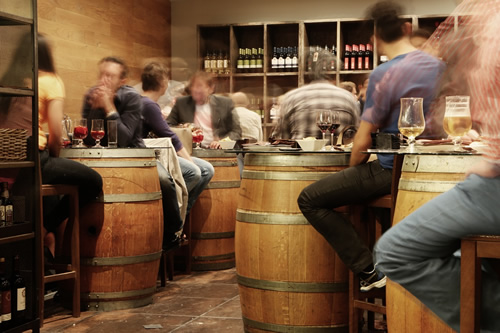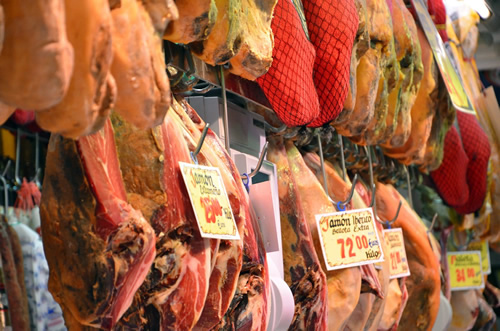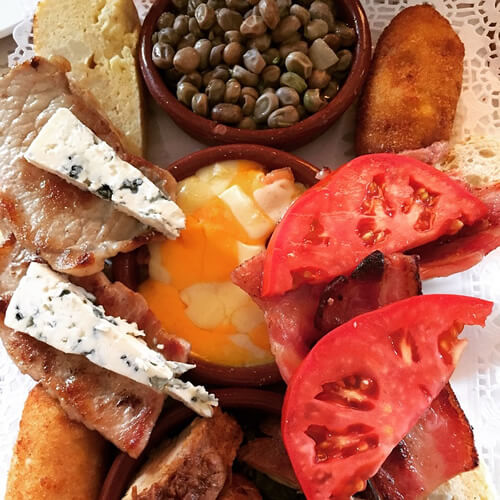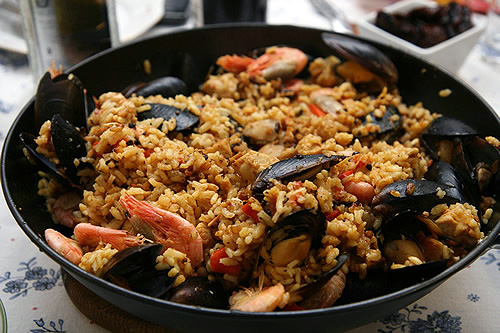When, Where and How to Eat Well in
Madrid
From a Tapas-Bar Spree to a Paella Feast
Articles and
photo by Beebe Bahrami
 |
|
Tapas bars in Madrid can be found everywhere deep into the night.
|
With the celebrity of certain Spanish
chefs, prepared food in Spain, which was already good, has
gotten only better. One of the keys is to understand a few
guiding principals that are a bit different from visiting
other European countries. It is also great to cultivate
a good sense of adventure and explore neighborhoods off
the usual tourist path. Plus, trust your instinct when you
look inside a restaurant window. It’s usually a good
guide in Madrid where restaurants abound on nearly every
street amid the many bars serving tapas most of the day.
Here are some initial ideas to help
you get started. Keep in mind that the Spanish are very
regional eaters. Each region focuses on its specialties,
based on market freshness and seasonal harvest and catch.
Eating in Madrid, as in a sleepy coastal village in Asturias,
is local and the quality of the food is local. The vegetables,
cheeses, meats, herbs, fruits, and wines all came from down
the road. So, in Madrid, eat Castilian.
Well, you might ask, what exactly is Castilian
food?
Castilian Cuisine 101
 |
| One of the many great Jamoneria (cured ham shops) in Madrid. |
This is the food of shepherds and farmers.
It is a hearty, rich, centuries old cuisine based on meats,
stews, beans, winter vegetables, cheeses, eggs, wines, and
strong other-world spice infusions like several varieties
of smoked and ground red peppers, a specialty developed
from New World imports, or saffron-rich sauces and soups,
a legacy from the medieval Middle Eastern foothold in Spain.
These all intersect in unique and delicious ways in Madrid
in the center of Spain.
Regional food in Madrid is defined
first and foremost by the Castilian cocido, a rich,
hearty stew filled with the season’s vegetables and
some form of meat, if not several meats. Often chickpeas
are also in the mix It is a perfect dish for the very cold
winters that rip through the meseta, the plateau
on which Madrid stands. By contrast, in the very hot summers,
Madrid’s food lightens up while still using the same
spices. Madrid has its own gazpachos, seasonal salads, and
roasted meats (asados), as well as the ubiquitous
cured hams, cheeses and olives.
Also, to eat really well in Madrid,
you need to change how you think about ordering food. Food
here isn’t about individual courses. It is about sharing
plates and eating family style. Graze, talk to the waiter,
ask what is seasonal, and order for the table. Most waiters
in Spain are a proud professional class who stick with their
jobs — and their place of work — for a lifetime.
They know their clientele and what good food is, as well
as who makes it, who picks it, who cooks it, and what wine
tastes great with it.
Lunch, around 2:00 pm, is the biggest
meal of the day. Dinner, anywhere between 9:00 and 11:00
pm, is smaller and more casual. I have found that
the best tactic to eating well in Spain in general is to
eat a large meal at lunch and then tapas for dinner. An
added bonus to this method is that if you are hungry earlier
than the Spanish dinner hour, tapas are available at any
time of the day. In fact you can quite easily eat anything,
anytime of day, for nearly 24 hours in Spain and no one
will lift an eyebrow.
The Art of Tapas: They’re
Not Just Snacks
 |
| A plate of assorted tapas to share. Photo by tamsinhenderson. |
While little plate snacks are a style
of eating in many Mediterranean nations, the Spanish art
of eating tapas is unique in its offering and its styles.
If you master this art form alone, you will eat incredibly
well in Madrid and may even look at a regular sit-down meal
with suspicion. A tapear, to go out for tapas,
asks for a bit of the daredevil but with little risks; if
you order something you don’t like, chances are it's
a small serving anyhow and you can order something else.
Classically there are two styles of
offering and ordering tapas. Some eateries have an array
of large plates of tapas on their counter and you point
at the ones you want and the waiter or bartender will fix
you several plates of chosen items, sometimes cooking it
up on the grill so it arrives nice and hot (this is popularly
referred to as the Madrileño style). Other places
have plates with single-serving tapas built on slices of
bread with a toothpick holding the sculpture together (popularly
the Bilbao style). Again, you point at what you want and
the waiter will place one of each on your plate. At the
end, he or she will simply count the number of toothpicks
on your plate and ring up your tapa tab along with the cost
of your drinks. In establishments like both these, where
the offering is on display on counters, it is as easy as
one person or six to order tapas. Other places might list
a menu on a card or chalk board. There you might find the
words “racion,” “media-racion,” “tapa,” as
well as “pincho.” In each eating place, these
listings might mean different quantities of things. But
usually a pincho is a little bite, for one person,
a tapa is a small serving but a bit bigger than a pincho,
a “media-racion” is a half large serving and
a “racion” is a large ration or full plate for
several people. To just taste small portions, you can ask, “Que
hay a picar?” (What’s there to nosh?) or point
at what you want and say either “a picar” or “para
uno.”
In Madrid some of the best tapeando
happens around the streets radiating to and from Plaza Santa
Ana. A great tapa place near here is Café de
la Abuela, on Calle Echegaray, 9. It is on a narrow
corner where, inside, beautiful dishes of tapas await your
order to be thrown on the grill and served piping hot.
In Chueca neighborhood, not far from
the Chueca plaza and metro stop, is another delightful tapa
and wine bar, Vinoteca Chueca, on Calle
Gravina, 6, that serves delicious tapas along with a terrific
wine list by the glass.
A sampling of some of the most common
tapas includes: grilled shrimp kabobs, grilled paprika-seasoned
pork kabobs, olive oil sautéed little green pepper
with a dash of sea salt (pimientos de Padrón),
garlic sautéed mushrooms, artisanal cheeses, olives,
sausages and Iberian cured ham, wedges of Spanish omelet
with potatoes and caramelized onions (tortilla española),
marinated grilled vegetables, marinated or salsa stuffed
mussels, fried artichoke hearts…Each day the offering
might be different depending on what was best at market
that morning. If you order several of these little dishes,
along with an ensalada mixta — a salad of lettuce,
tomatoes, onions, and any number of toppings such as tuna,
corn, hard-boiled egg wedges, olives, shredded carrots and
beets — you could make this a substantial meal.
Lunch as the Main Meal: Eating
Like the Locals
You can make lunch your main meal and
sample the lunchtime only menu del dia, a fixed
price fixed menu restaurants across town offer with several
choices per course that adds up to a three-course meal (two
entrees, dessert, wine, beer or mineral water and bread)
where the chef has selected the most seasonal and fresh
ingredients. Moreover, get away from the Prado and Plaza
Mayor areas at lunch time and instead go into the local
neighborhoods where the food is better. For instance, explore
these spots (good for lunch and dinner):
- The area around Plaza de Santa Ana
- The streets in and around Chueca,
such as all along Calle Gravina, between Calle de Hortaleza
and Paseo de Recoletos (near which Gravina stays the
same street but changes names to Calle del Almirante)
where there are a string of interesting restaurants.
A favorite place on this stretch is El Cuatro
de Xiquena on Calle Conde de Xiquena, 4, which
intersects with Calle del Almirante.
- The district around the metro stop “Opera” has
interesting new and old restaurants. My current favorite
here is Restaurant Chic, serving pan-Iberian
fusion food. I had a bring-me-to-my-knees chocolate almond
flan here. I also had scrambled eggs with wild mushrooms,
which were just right. Then there was the spring squash
and noodle dish. It is on Calle Campomanes 5.
- On Calle Atocha 14, right off of
the Plaza Jacinto Benavente is Medina Mayrit a
Middle Eastern/North African/Iberian fusion cuisine place
with a teahouse and an attached spa. Reservations are
recommended for anything more involved than a cup of
tea. Even if all you do is tea here, try some of the
unique herbal infusions.
- For truly classic Madrileño
Castilian cuisine, try the bull-fighter afficionado’s
restaurant, Restaurante Salvador on
Calle Barbieri, 12, near the intersection with Calle
San Marcos just north of the Gran Via.
Great Vegetarian Food in the Land
of Meat Eaters and Ham Museums
Vegetarians in general have been
challenged by Spanish cuisine, which often builds itself
around meat. But as the capital, Madrid has some of the
best selection of vegetarian restaurants in Spain. You
can find out about the growing offering through the local
free publication, Red Alternativa, available
in health food (bio) and New Age stores. Here are a couple
recommended veggie restaurants:
- El Restaurante Vegetariano,
Calle Marqués de Santa Ana, 34 (at the corner
of Calle Espiritu Santo)
- Restaurante Vegetariano
Artemisa, Calle Tres Cruces, 4 (near the
Plaza del Carmen)
A Word on Wine
Madrid is also delightfully at
the intersection of several nearby and well-known wine
regions: the Penedes in Cataluña to the east;
the Rioja, Aragon and Navarra regions just to the northeast;
the Ribeira de Duero and Rueda north and east, Galicia’s
Rías Baixas and Ribeiro to the northwest, the
vast La Manchan wineries to its immediate south, and
Madrid’s own Vinos de Madrid region to the west
of the city. These all pair beautifully with the smoked
pepper, cured olives and hams, and roasted vegetables,
lamb, and legumes of Castilian cooking.
So often in dining out, the house wine
is the best wine value. The owner and chef know what they
are doing when they pick it and as they are in the heart
of one of the world’s major wine-producing nations,
where some of its best wines can be procured cheaply enough
to be a house wine.
A Final Word on Paella
Now, to the best paella. Don’t
seek it out in Madrid. I’m sorry. Leave Madrid. Try
paella if you are anywhere between the Costa Brava and Valencia.
And absolutely avoid the great big outdoor paella on the
beach in Valencia. It is too big and sits outside forever.
One friend who lives in Valencia told me he got food poisoning
from that great vat. Avoid it no matter how romantic it
looks. Try instead paella at one of many little eateries
in the Carmen neighborhood of Valencia that offer it as
a part of their daily fixed menu special, the menu del
dia. One of the best paellas I ever had came out of
such a place. Curiously, it was a vegetarian paella. All
the vegetables had been slow oven roasted first, with olive
oil and garlic, before being turned into the rice sauté and
slowly simmered. Another best paella I had was at a restaurant
in Besalú, Cataluña, done Catalan style with
little flat thin noodles instead of rice (more commonly
known as fideua). But the truly best of the best
paellas I’ve ever eaten was made by a friend’s
father in their back yard in Seville on the outdoor grill.
That in the end might be the secret to really good paella — having
a friend prepare it fresh just for you — or if you have a vacation rental, learn to make it yourself with local ingredients.
 |
| A really good paella can be hard
to find, especially in Madrid. |
Beebe Bahrami is a freelance writer and cultural anthropologist specializing
in travel, food and wine, and cross-cultural writing.
|
